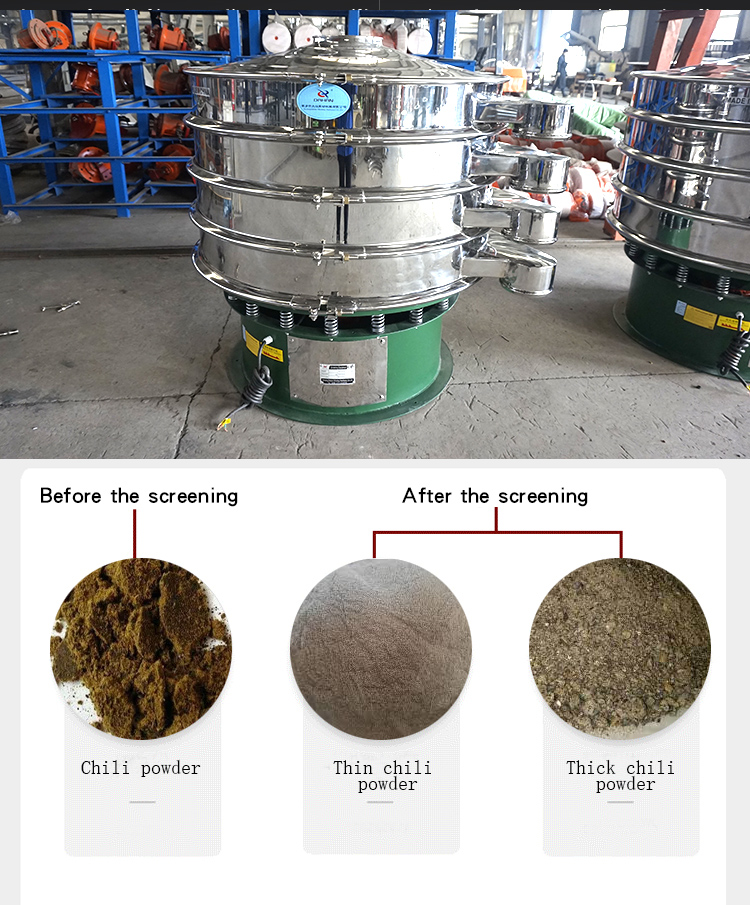Sieving machines can be used for classifying de-oiled castor cake by separating the particles based on their size. De-oiled castor cake is a byproduct of castor oil production that is rich in nutrients and can be used as an organic fertilizer or animal feed.

The mesh range of de-oiled castor cake can vary depending on the specific application and desired particle size distribution. However, a common mesh range for sieving de-oiled castor cake is typically between 20 mesh and 80 mesh.

The commonly used mesh sizes of De Oiled Castor Cake sieving machine can vary depending on the specific requirements and applications. However, typically, mesh sizes ranging from 4 to 120 mesh are commonly used. Here's a general breakdown of the mesh sizes and their corresponding opening sizes:
4 mesh: Opening size of approximately 4.75 mm (0.187 inches)
10 mesh: Opening size of approximately 2.00 mm (0.0787 inches)
20 mesh: Opening size of approximately 0.85 mm (0.0331 inches)
40 mesh: Opening size of approximately 0.425 mm (0.0165 inches)
60 mesh: Opening size of approximately 0.25 mm (0.0098 inches)
80 mesh: Opening size of approximately 0.18 mm (0.0070 inches)
100 mesh: Opening size of approximately 0.15 mm (0.0059 inches)
120 mesh: Opening size of approximately 0.125 mm (0.0049 inches)
These mesh sizes are just examples, and the actual mesh sizes used in the sieving process may vary depending on the desired particle size distribution and the specific requirements of the castor cake processing industry. It's important to consult with equipment manufacturers or industry experts to determine the appropriate mesh sizes for a particular application.
De-oiled castor cake can contain particles of different sizes, which can affect the nutrient content and consistency of the final product. Sieving helps to ensure that the particles are of a uniform size, which can improve the effectiveness of the cake as a fertilizer or animal feed.
1Sieving machines can also be used to remove any foreign objects or impurities from the de-oiled castor cake, which can improve the overall quality of the final product. This is particularly important for applications where the de-oiled castor cake will be used as an animal feed, as any contaminants can be harmful to the animals.
2In addition to improving the quality of the final product, the use of sieving machines can also improve the efficiency of the processing operation. By separating the particles based on their size, the sieving process can help to optimize downstream processing operations, such as mixing and packaging.

There are several advantages of using a sieving machine in the processing of de-oiled castor cake, including:
Improved Product Quality: Helps remove any foreign matter or impurities in the deoiled castor cake, ensuring the final product is of higher quality and safe to use as fertilizer or animal feed.
Consistent Particle Size: Screeners help ensure uniform particle size in deoiled castor cake, which can improve the cake's effectiveness as fertilizer or animal feed. This also helps optimize downstream processing operations such as blending and packaging.
Increased Processing Efficiency: It is possible to help improve the efficiency of processing operations by automating the particle separation process. This saves time and labor costs, and also reduces the risk of human error.
Safe and Hygienic Processing Environment: Designed to contain deoiled castor cake and prevent it from escaping into the surrounding environment. This helps reduce the risk of dust and other contaminants in the processing environment, improving worker safety and hygiene.
Here is an example of a customer case involving the use of a sieving machine in the processing of de-oiled castor cake:
A fertilizer manufacturer in India was producing de-oiled castor cake as an organic fertilizer. The company was experiencing issues with the consistency of the particle size distribution in the de-oiled castor cake, which was affecting the effectiveness of the fertilizer.
Challenge: Castor meal contains 9-12% of moisture which tends to form soft lumps & agglomerates. These lumps chock the mesh & hinder the production output, as well as wasteage in the form of lumps, which is increased. Also, the dry castor meal had very tiny particles that would lead to a lot of dusting while sorting it into a giant vibrating sorter. Heavy dusting would result in frequent cleaning & maintenance.
The real challenge was to make a vibrating sieve that could overcome the problem of product waste in form of lumps & a system that would clean the dusting automatically, along with the technology that promotes continuous sieving & classifying process.

Result: To address this issue, the company invested in a ultrasonic vibrating screen to separate the particles based on their size. The machine was able to remove any oversized or undersized particles, as well as any foreign objects or impurities, resulting in a more consistent and higher quality final product. And the application of ultrasonic deblinding system also avoids agglomeration leading to product waste and screen blockage.

Overall, the use of a sieving machine in the processing of de-oiled castor cake can result in a higher quality final product, increased efficiency, and a safer and more hygienic processing environment.
Address:China,Yanjin county forest park gate to the west 1000 meters north road.